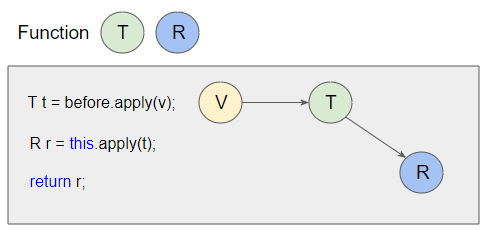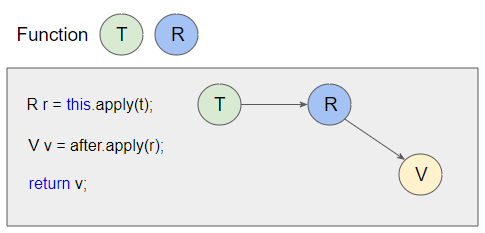Руководство Java Function
1. Function interface
В Java 8,Function - это functional interface, который представляет собой оператор, принимающий входное значение и возвращающий значение.
Исходный код interface Function:
Function interface
package java.util.function;
import java.util.Objects;
@FunctionalInterface
public interface Function<T, R> {
R apply(T t);
default <V> Function<V, R> compose(Function<? super V, ? extends T> before) {
Objects.requireNonNull(before);
return (V v) -> apply(before.apply(v));
}
default <V> Function<T, V> andThen(Function<? super R, ? extends V> after) {
Objects.requireNonNull(after);
return (T t) -> after.apply(apply(t));
}
static <T> Function<T, T> identity() {
return t -> t;
}
}Например:
FunctionEx1.java
package org.o7planning.ex;
import java.util.function.Function;
public class FunctionEx1 {
public static void main(String[] args) {
Function<String, Integer> func = (text) -> text.length();
int length = func.apply("Function interface tutorial");
System.out.println("Length: " + length);
}
}Output:
Length: 27Например: Обработка элементов объекта List для создания нового объекта List.
FunctionEx2.java
package org.o7planning.ex;
import java.util.ArrayList;
import java.util.Arrays;
import java.util.List;
import java.util.function.Function;
public class FunctionEx2 {
public static void main(String[] args) {
Function<String, String> func = text -> text.toUpperCase();
List<String> list = Arrays.asList("Java", "C#", "Python");
List<String> newList = map(func, list);
newList.forEach(System.out::println);
}
public static <T,R> List<R> map(Function<T,R> mapper, List<T> list) {
List<R> result = new ArrayList<R>();
for(T t: list) {
R r = mapper.apply(t);
result.add(r);
}
return result;
}
}Output:
JAVA
C#
PYTHONНапример: Использование Function для преобразования объекта List в объект Map:
FunctionEx3.java
package org.o7planning.ex;
import java.util.Arrays;
import java.util.HashMap;
import java.util.List;
import java.util.Map;
import java.util.function.Function;
public class FunctionEx3 {
public static void main(String[] args) {
Function<String, Integer> func = text -> text.length();
List<String> list = Arrays.asList("Java", "C#", "Python");
Map<String, Integer> map = listToMap(func, list);
// @see: Map.forEach(BiConsumer).
map.forEach((t,r) -> System.out.println(t + " : " + r));
}
public static <T,R> Map<T,R> listToMap(Function<T,R> mapper, List<T> list) {
Map<T, R> result = new HashMap<T, R>();
for(T t: list) {
R r = mapper.apply(t);
result.put(t, r);
}
return result;
}
}Output:
C# : 2
Java : 4
Python : 6- BiFunction
- IntFunction
- LongFunction
- DoubleFunction
- Supplier
- Predicate
- BiPredicate
- Consumer
- BiConsumer
2. Function + Method reference
M.ref example 1:
Если статический метод принимает один параметр и возвращает значение, его ссылка может рассматриваться как Function.
Function_mref_ex1.java
package org.o7planning.ex;
import java.util.function.Function;
public class Function_mref_ex1 {
public static void main(String[] args) {
// A method of Math class: public static long round(double)
Function<Double, Long> func1 = Math::round; // Method reference
Function<Double, Long> func2 = value -> Math.round(value);
System.out.println(func1.apply(100.7));
System.out.println(func2.apply(100.7));
}
}Output:
101
101M.ref example 2:
Если нестатический метод (non-static method), не принимает параметров и возвращает значение, то его ссылку можно рассматривать как Function.
Function_mref_ex2.java
package org.o7planning.ex;
import java.util.function.Function;
public class Function_mref_ex2 {
public static void main(String[] args) {
// A method of String class: public int length()
Function<String, Integer> func1 = String::length; // Method reference
Function<String, Integer> func2 = text -> text.length();
System.out.println(func1.apply("Java")); // 4
System.out.println(func2.apply("Java")); // 4
}
}M.ref example 3:
Далее, взгляните на класс CurrencyFormatter ниже:
- Метод CurrencyFormatter.usd(double) имеет параметр типа Double и возвращает String. Таким образом, его ссылку CurrencyFormatter::usd можно рассматривать как Function<Double,String>.
CurrencyFormatter.java
package org.o7planning.tax;
public class CurrencyFormatter {
// Dollar
public static String usd(double amount) {
return "$" + amount;
}
// Euro
public static String euro(double amount) {
return "€" + amount;
}
// Vietnam Dong.
public static String vnd(double amount) {
return amount + "VND";
}
}TaxCalcExample.java
package org.o7planning.tax;
import java.util.function.Function;
public class TaxCalcExample {
public static void main(String[] args) {
double amount = 1000;
String format = formatCurrency("VN", amount);
System.out.println("VN: " + format);
format = formatCurrency("US", amount);
System.out.println("US: " + format);
format = formatCurrency("EU", amount);
System.out.println("EU: " + format);
}
public static String formatCurrency(String countryCode, double amount) {
if ("VN".equals(countryCode)) {
Function<Double, String> formatter = CurrencyFormatter::vnd; // Method reference
return _formatCurrency(formatter, amount);
}
if ("US".equals(countryCode)) {
return _formatCurrency(CurrencyFormatter::usd, amount);
}
if ("EU".equals(countryCode)) {
return _formatCurrency(CurrencyFormatter::euro, amount);
}
throw new RuntimeException("No formatter for " + countryCode);
}
private static String _formatCurrency(Function<Double, String> formatter, double amount) {
return formatter.apply(amount);
}
}Output:
VN: 1000.0VND
US: $1000.0
EU: €1000.03. Function + Constructor reference
Как вы знаете, constructor используется для создания объекта, это означает, что он возвращает значение. Таким образом, если constructor имеет один параметр, его ссылка будет рассматриваться как Function.
Student.java
package org.o7planning.cr;
public class Student {
private String name;
public Student(String name) {
this.name = name;
}
public String getName() {
return name;
}
public void setName(String name) {
this.name = name;
}
}ConstructorReferenceTest.java
package org.o7planning.cr;
import java.util.function.Function;
public class ConstructorReferenceTest {
public static void main(String[] args) {
Function<String, Student> f1 = Student::new; // Constructor Reference
Function<String, Student> f2 = (name) -> new Student(name); // Lambda Expression
System.out.println(f1.apply("Tom").getName());
System.out.println(f2.apply("Jerry").getName());
}
}Output:
Tom
Jerry4. Function Usages
Ниже приведен список методов в package java.util, использующих interface Function:
static
<T,U extends Comparable<? super U>> Comparator<T> | Comparator.comparing(Function<? super T,? extends U> keyExtractor) |
static <T,U> Comparator<T> | Comparator.comparing(Function<? super T,? extends U> keyExtractor, Comparator<? super U> keyComparator) |
V | Hashtable.computeIfAbsent(K key, Function<? super K,? extends V> mappingFunction) |
V | HashMap.computeIfAbsent(K key, Function<? super K,? extends V> mappingFunction) |
default V | Map.computeIfAbsent(K key, Function<? super K,? extends V> mappingFunction) |
<U> Optional<U> | |
<U> Optional<U> | |
default
<U extends Comparable<? super U>> Comparator<T> | Comparator.thenComparing(Function<? super T,? extends U> keyExtractor) |
default <U> Comparator<T> | Comparator.thenComparing(Function<? super T,? extends U> keyExtractor, Comparator<? super U> keyComparator) |
5. Function.compose(Function before)
Вот определение метода Function.compose:
@FunctionalInterface
public interface Function<T,R> {
R apply(T t);
default <V> Function<V, R> compose(Function<? super V, ? extends T> before) {
Objects.requireNonNull(before);
return (V v) -> apply(before.apply(v));
}
// Other default methods ..
}И мы перепишем этот метод более простым для понимания способом:
@FunctionalInterface
public interface Function<T,R> {
R apply(T t);
default <V> Function<V, R> compose(Function<? super V, ? extends T> before) {
Objects.requireNonNull(before);
return (V v) -> {
T t = before.apply(v);
R r = this.apply(t);
return r;
};
}
// Other default methods ..
}
Например:
FunctionEx6.java
package org.o7planning.ex;
import java.util.function.Function;
public class FunctionEx6 {
public static void main(String[] args) {
Function<String, Integer> func = content -> content.length();
Function<Article, String> before = article -> article.getContent();
Article article = new Article("Java Tutorial", "Java Tutorial Content...");
int contentLength = func.compose(before).apply(article);
System.out.println("The length of the article content: " + contentLength);
}
}
class Article {
private String title;
private String content;
public Article(String title, String content) {
this.title = title;
this.content = content;
}
public String getTitle() {
return title;
}
public String getContent() {
return content;
}
}Output:
The length of the article content: 246. Function.andThen(Function after)
Вот определение метода Function.andThen:
@FunctionalInterface
public interface Function<T, R> {
R apply(T t);
default <V> Function<T, V> andThen(Function<? super R, ? extends V> after) {
Objects.requireNonNull(after);
return (T t) -> after.apply(apply(t));
}
// Other default methods ..
}И мы перепишем этот метод более простым для понимания способом:
@FunctionalInterface
public interface Function<T, R> {
R apply(T t);
default <V> Function<T, V> andThen(Function<? super R, ? extends V> after) {
Objects.requireNonNull(after);
return (T t) -> {
R r = this.apply(t);
V v = after.apply(r);
return v;
};
}
// Other default methods ..
}
Например:
FunctionEx7.java
package org.o7planning.ex;
import java.util.function.Function;
public class FunctionEx7 {
public static void main(String[] args) {
Function<Post, String> func = post -> post.getContent();
Function<String, Integer> after = content -> content.length();
Post post = new Post("Java Tutorial", "Java Tutorial Content...");
int contentLength = func.andThen(after).apply(post);
System.out.println("The length of the post content: " + contentLength);
}
}
class Post {
private String title;
private String content;
public Post(String title, String content) {
this.title = title;
this.content = content;
}
public String getTitle() {
return title;
}
public String getContent() {
return content;
}
}Output:
The length of the post content: 247. Function.identity()
Статический метод Function.identity(): Возвращает функцию, которая всегда возвращает свой входной аргумент.
static <T> Function<T, T> identity() {
return t -> t;
}Например: Преобразует массив в объект Set, содержащий неповторяющиеся элементы.
FunctionEx8.java
package org.o7planning.ex;
import java.util.Arrays;
import java.util.Set;
import java.util.function.Function;
import java.util.stream.Collectors;
public class FunctionEx8 {
public static void main(String[] args) {
String[] names = new String[] { //
"Peter", "Martin", "John", "Peter", //
"Vijay", "Martin", "Peter", "Arthur" };
Set<String> set = Arrays.asList(names).stream() //
.map(Function.identity()).collect(Collectors.toSet());
set.forEach(System.out::println);
}
}Output:
Vijay
Arthur
John
Martin
PeterПриведенный выше пример эквивалентен приведенному ниже примеру:
FunctionEx8a.java
package org.o7planning.ex;
import java.util.Arrays;
import java.util.Set;
import java.util.stream.Collectors;
public class FunctionEx8a {
public static void main(String[] args) {
String[] names = new String[] { //
"Peter", "Martin", "John", "Peter", //
"Vijay", "Martin", "Peter", "Arthur" };
Set<String> set = Arrays.asList(names).stream() //
.map(t -> t).collect(Collectors.toSet());
set.forEach(System.out::println);
}
}Java Basic
- Настройте java compiler для обработки вашего Annotation (Annotation Processing Tool)
- Программирование на Java для группы с помощью Eclipse и SVN
- Руководство Java WeakReference
- Руководство Java PhantomReference
- Сжатие и декомпрессия в Java
- Настройка Eclipse для использования JDK вместо JRE
- Методы String.format() и printf() в Java
- Синтаксис и новые функции в Java 8
- Регулярные выражения Java
- Руководство Java Multithreading Programming
- Библиотеки Java JDBC Driver для различных типов баз данных
- Руководство Java JDBC
- Получить значения столбцов, автоматически возрастающих при вставлении (Insert) записи, используя JDBC
- Руководство Java Stream
- Руководство Java Functional Interface
- Введение в Raspberry Pi
- Руководство Java Predicate
- Абстрактный класс и Interface в Java
- Модификатор доступа (Access modifiers) в Java
- Руководство Java Enum
- Руководство Java Annotation
- Сравнение и Сортировка в Java
- Руководство Java String, StringBuffer и StringBuilder
- Обработка исключений Java - Java Exception Handling
- Руководство Java Generics
- Манипулирование файлами и каталогами в Java
- Руководство Java BiPredicate
- Руководство Java Consumer
- Руководство Java BiConsumer
- Что мне нужно для начала работы с Java?
- История Java и разница между Oracle JDK и OpenJDK
- Установить Java в Windows
- Установите Java в Ubuntu
- Установите OpenJDK в Ubuntu
- Установить Eclipse
- Установите Eclipse в Ubuntu
- Быстрое изучение Java для начинающих
- История бит и байтов в информатике
- Типы данных в java
- Битовые операции
- Команда if else в Java
- команды switch в Java
- Циклы в Java
- Массивы (Array) в Java
- JDK Javadoc в формате CHM
- Наследование и полиморфизм в Java
- Руководство Java Function
- Руководство Java BiFunction
- Пример Java encoding и decoding с использованием Apache Base64
- Руководство Java Reflection
- Java Удаленный вызов методов - Java RMI
- Руководство Программирование Java Socket
- Какую платформу я должен выбрать для разработки приложений Java Desktop?
- Руководство Java Commons IO
- Руководство Java Commons Email
- Руководство Java Commons Logging
- Понимание Java System.identityHashCode, Object.hashCode и Object.equals
- Руководство Java SoftReference
- Руководство Java Supplier
- Аспектно-ориентированное программирование Java с помощью AspectJ (AOP)
Show More
- Руководства Java Servlet/JSP
- Руководства Java Collections Framework
- Java API для HTML, XML
- Руководства Java IO
- Руководства Java Date Time
- Руководства Spring Boot
- Руководства Maven
- Руководства Gradle
- Руководства Java Web Services
- Руководства Java SWT
- Руководства JavaFX
- Руководства Oracle Java ADF
- Руководства Struts2 Framework
- Руководства Spring Cloud